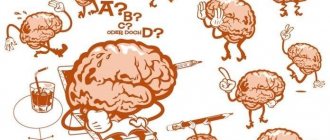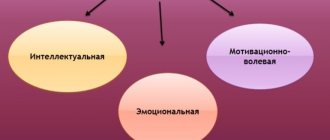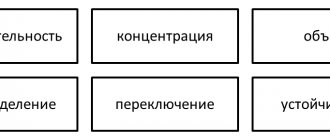Regardless of the current stage in the development of each person, work with intellectual progress and in particular with attention training should never end. This process is as natural as the growth and training of muscle fibers, which occurs throughout life and in the absence of movement, leads to irreversible destructive consequences.
Attention improves the perception of the surrounding world and new knowledge about it, both in children and adults, in the process of their daily social interactions, this function receives training naturally, however, special exercises for the development of attention will help optimize and improve the process of acquiring new knowledge and skills . An attentive student always shows significantly higher results in learning, because he more effectively fills his working memory with the necessary information, filtering out external stimuli.
Controlling your attention is very important in any field of activity; this ability is achieved through regular training; as a result, a person gets the desired result and becomes a valuable employee and an interesting interlocutor who does not lose sight of important details and is not distracted by minor details.
Features of the development of attention and memory
Objects of attention - animate, inanimate objects, natural phenomena, science, art, present in the field of view. All this is of sufficient interest or predetermined by the need for research. For the development of attention, age factors of people and the presence of determination are important. In addition to interest in a subject or phenomenon, systematic exercise is required. Listing the features of the development of a function, we will consider the properties and characteristics on which the process depends.
Three types of attention
- Involuntary, in which there is no conscious choice on the part of the subject. It appears when exposed to a stimulus that causes one to be distracted by another object. This variety is difficult to control, being associated with the internal organization of a person.
- Voluntary form is conscious concentration on an object. The process occurs with motivation and understanding. Its characteristic is stability. The development of voluntary attention is associated with the formation of perseverance and willpower when the psyche is activated. During intense mental work, you need to take breaks. The brain is activated, activities receive motivation. The development of voluntary attention is associated with the presence of significant interest.
- The post-voluntary type appears in this form when the subject performs a task without tension. The sense of purpose here is very significant, and internal motivation prevails over external motivation.
Properties of attention
- Concentrating or maintaining attention on a subject works well if there is motivation. In this case, consciousness controls the intensity parameter in the process. It is estimated that a person can focus continuously for anywhere from half an hour to 40 minutes, after which a break is necessary.
- Attention span is a property characterized by the number of objects that can be simultaneously held in consciousness.
- The ability to pay attention to one object for a long time without switching to another is called stability. This property allows you to discover new things in everyday things.
- Switchability is a property characterized by a meaningful change in the focus of attention, which is caused by external circumstances. A variation is simple distractibility.
- Distribution is the ability to focus on several objects at once. Transitions from one object to another depend on the relationship between them. The process can lead to fatigue.
Features of types of attention
What can the development of human attention depend on, including the features of this function? The process is associated with the ability to focus on one or more objects for some time without distraction. This requires interest. The development of voluntary attention requires focus and willpower. And also mastery of the senses, which determines concentration without inappropriate distraction. The involuntary variety involves the presence of an interesting-looking object. The post-voluntary form is especially productive. After all, no additional effort is required to overcome. These are the features with which the development of human attention is endowed.
Regular exposure
Choose something directly in your field of vision, such as a pencil, and tell yourself as forcefully as possible: “Look at this pencil!” Then pause and wait for your consciousness to respond to the order. The pencil will appear more clearly in your thoughts. Record the reaction of your consciousness by mentally saying: “Excellent.” Now repeat the same thing several times: “Look at this pencil! - Pause. - Great". “Look at this pencil! - Pause. - Great". Pay attention to the “quality” of your attention. Note the time when the response occurs; determine how quickly your mind reacts. Check to see if he begins to respond faster with training. So, look around and focus your attention on something.
Development of attention in children and preschoolers
Recommendations for developing attention in children suggest weekly training. After all, their mental functions are at the stage of formation. Corrective exercise or training is applied to a variety of properties and types of attention. The following techniques will help you learn to focus and switch.
- It is better to present information in a playful way, trying to interest the child.
- Techniques for developing attention aim to bring things to the end, for which it is necessary to motivate children to complete the work in this way.
- Logical thinking is trained through interesting tasks and questions.
- Actions aimed at developing attention should be accompanied by an explanation of the importance of the process. It should be explained that with concentration, writing (letters and numbers) becomes accurate. Any action is better if you don’t get distracted.
- You need to ask the child to listen to stories, after which he will tell what he remembers.
Such recommendations for developing attention teach accuracy and develop the ability to concentrate correctly. Various tables and tasks have been created for children under 6 years of age. For example, you need to complete what is missing in the picture or connect objects. Techniques for developing attention are reflected in books for children by Elena Bortnikova. Tasks are given to complete a number of geometric shapes, understanding the patterns. Or reproduce the whole from half - complete the missing part of the picture, find differences in two images.
Some methods of developing attention do not require preliminary preparation. You can exercise while walking. When throwing a ball to the child, we pronounce edible and inedible objects. In the first case, the baby catches it, in the second, he throws it away. The development of visual attention occurs if you ask to tell what you saw on an unfamiliar walking route. By practicing every day, you can achieve significant success.
Size value
The sizes of individual forms and the overall composition indicate self-esteem. Explanation:
- Drawings that take up all the free space on the sheet indicate that the person cannot achieve anything in life and tries to compensate for this with an image. More often these are extroverted people who cannot truly realize themselves in their endeavors.
- Large drawings indicate high self-esteem. Very large figures may indicate that the subject is characterized by excessive pride, vanity, and arrogance. The deep reason for the manifestation of these feelings is dissatisfaction with the usual life.
- A large amount of empty space on a sheet of paper is typical for introverts. Such people are constrained, pressed into themselves, afraid of something new. They do not trust others and are afraid to make mistakes.
Development of attention in adults
A wide variety of techniques and methods have been developed that give results in training concentration and mind control. Exercises aimed at developing attention concern all its types and properties.
- For concentration skills, you need to choose an object and try to hold psychic energy on it for some time. Having placed the book in front of us, we try to imagine the characters and content. The following exercise is done with two objects, which ensures the development of voluntary attention and the ability to switch.
- To increase the level of your abilities, you need to learn how to manage them. This skill will help you overcome emerging difficulties. Some people constantly experience the same problem: difficulty perceiving details or an entire object. In this case, it is recommended to change training objects daily.
- The development of visual attention should expand the ability to concentrate. It is necessary to highlight the maximum number of details in the subject under consideration. At the very beginning of five minutes of concentration, a general idea of color, shape, and size will arise. And then little things and details will appear that you should definitely look out for.
- Exercises to develop auditory attention improve this type of attention. For example, they concentrate on a voice for 10 minutes. It could be a speech, birdsong, a song or a melody for relaxation. It is important to distinguish the speaker’s speed, emotionality, and identify the benefits of the information. Exercises to develop auditory attention also include listening to texts or songs and playing them.
Trainers for developing attention online
There are many resources on the Internet that help you develop your abilities. A trainer for concentration and speed of thought - “Anagrams”. Rounds are held in a game form, during which you need to complete tasks under time constraints. The number of points depends on this. Another simulator for effective development of attention is the Schulte table. The brain and the ability to visual search will be activated. Speed reading capabilities are improved. The tables are made up of letters and numbers randomly placed in them, in relation to which tasks are given to find symbols and count. The process also stimulates the development of visual attention.
There are many games. For example, “Tag” gives a good workout to the brain and develops logic. Simulators that develop lateral vision and speed reading are useful.
Exercises to develop attention
A number of methods that shape abilities take into account factors influencing the spheres of consciousness. So, exercises to develop attention include the formation of diction. Trainings are used to improve speech, containing tasks for thinking. The learner focuses on how he pronounces letters and sounds. Also, methods of developing attention are aimed at improving logic. An IQ test consists of a variety of tasks that measure the ability to notice details.
Having dealt with the factors, we move on to training individual functions. We can recommend the following activities and exercises aimed at effectively developing attention.
- Concentration is trained using psychological methods. You should select an object (a tree or an animal) and observe it for 5 minutes. After this, the situation is complicated by turning on music or a television program. A person comes to the conclusion that function is better formed in the absence of distractions.
- The development of visual attention is carried out using a picture, which you need to look at for 5 minutes, after which you need to describe everything that you managed to remember. The number of parts reproduced determines the degree of success.
- Exercises to develop auditory attention can train two functions at once. For example, your eyes and ears improve in terms of abilities if you listen to a conversation on a bus. It is also helpful to focus on the sounds of nature. Exercises to develop auditory attention are more effective the quieter the environment.
Corrective development exercises train the ability to switch attention and focus. For example, words are spoken to a child, and he must raise his hand if he hears a word related to the animal world. They make up a series of tasks to improve the speed and efficiency of perception and cognition. A correctional lesson can be conducted with a group of children or adults.
What does it depend on?
As I already said in the article about how to deal with inattention , that initially your attentiveness depends directly on your well-being, namely:
- Dream. Doctors recommend sleeping at least 8 hours a day, but everyone has their own individual norm that should be followed. It is difficult for the brain to tune in to work when there is a lack of energy, so concentration of attention is out of the question. If you have difficulty getting proper sleep, you can read my article “What to do if you wake up very early and don’t know what to do about it?”
- Nutrition. If you eat too much fatty food, or with a high sugar content, your body will not be able to actively expend energy, which will lead to laziness or apathy; you simply will not have the strength and need to switch your attention to external stimuli in order to receive new information.
- Walks in the open air. Oxygen is necessary for the active functioning of the brain. Have you noticed how after a walk in the fresh air your head becomes more “clear” and it is easier to concentrate afterwards? That is why at school children are asked to spend recess outside.
- Sports activities. It is not necessary to visit the gym or group classes; it will be quite enough if you do daily exercises to keep your body in good shape. Then attention will be activated.
- Calm. When under stress, a person usually has too high levels of anxiety, fear, anger, disappointment, surprise and other feelings. There are a large number of thoughts in the head, they are confused and interrupt each other, so sometimes a person may not even remember, for example, where he was and what he did for the last half hour, because he did not track reality while experiencing an emotional outburst. So these methods should be started when you are calm.
Recommendations for developing attention
Methods for developing attention during their implementation cannot be perceived only as part of the activity. These functions are also needed in everyday use. A person must be able to concentrate and notice important little things. Corrective exercises to develop abilities are intended for children and adults.
Everyone has their own level of attention. But everyone should definitely take appropriate classes, as this will help you become more successful. As a result, for example, you can get rid of absent-mindedness forever. The development of visual attention, auditory attention, and concentration sometimes includes simple exercises. But having mastered them, a person acquires the skill of focusing on life goals and objectives.
What is it in psychology: definition of the concept
Attention in psychology is a selective process that allows you to filter out and control information that is relevant at a given moment in time about certain manifestations or objects of the internal and external environment. In other words, attention allows you to ignore information that is not of value, preventing it from entering consciousness, while at the same time maintaining the ability to concentrate on events and sensations that are significant for a person.
In other words, attention allows you to ignore information that is not of value, preventing it from entering consciousness, while at the same time maintaining the ability to concentrate on events and sensations that are significant for a person.










